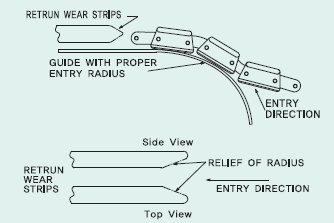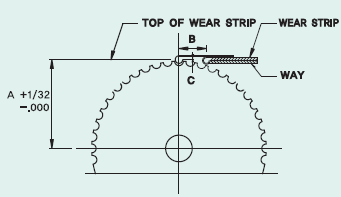|
|
 |
 |
Untitled Document
| 이미지를 클릭 하시면 해당제품을 보실 수 있습니다. |
|
 |
 |
| 컨베이어 관리
1 |
|
 |
| 컨베이어 관리
2 |
|
 |
| 컨베이어 관리
3 |
|
|
 |
|
 |
| |
| ● 청결 CLEANLINESS |
많은 상황에서, 기름칠, 먼지, 모래알, 쏟아진 시럽, 음료 등이 체인을 더럽힐
수 있다.
이러한 것들은 다음과 같은 결과를 낳게 된다.
In many cases, oil, dust, sand, spilled syrup and beverage
may damage the chain.
They can result in the following |
| |
· 이송되는 제품에 대한 손상
· 체인과 모터에 심한 부하를 준다.
· 가속화되는 스프로켓의 치형 마모를 초래한다.
· 컨베이어 마찰과 마모
· 플라이트와 접합부 상의 지나친 체인 마모.
· Wear strips의 빠른 마모. (slide rail 마모) |
|
· Damage to the goods being transported
· Overload to the chain and motor
· Causes wear to the accelerating sprocket keys
· Conveyor friction and wear
· Plate’s and connecting part’s excessive chain wear |
|
| |
체인과 컨베이어 프레임의 잦은 손질이 요구된다. 스팀, 따뜻한 물, 비누 등의 도구들을 사용하여 흔하게
쓰인다.
“클리너/ 윤활유”를 지속적으로 사용한다.
금속 체인과 함께 사용된 강한 부식성의 도구들은 플라스틱 체인과는 함께 사용되어선 안 된다.
항상 린스는 체인과 컨베이어에서 말끔히 제거되어야 한다. 지나친 양의 시럽 또는 다른 액체, 깨어진 유리
또는 쌓인 먼지 등
이 기계를 더럽힐 때는 그러한 물질들을 제거하기 위해 클리닝이 요구된다.
Chain and conveyor frame should be checked often. Steam, hot
water, and soap are commonly used.
Cleaner and lubricating oil should be used constantly.
Metal chain and other corrosive equipment should not be used
with plastic chain. Soap must be thoroughly removed from
chain and conveyor. Excessive amount of syrup, other liquid,
broken glass and dust must be cleaned off.
※주의: 모든 클리너와 윤활유는 체인과 컨베이어 재질을 변환시키는 재료를 사용해서는 안 된다.
※Caution: all cleaner and lubricating oil should not damage
the chain and conveyor. |
| |
| ● 주기적 점검 SCHEDULED
INSPECTION |
컨베이어가 작동 중에 체인, 스프로켓 등 시스템의 주기적 검사를 하여 오류를 찾아야
하며 심각한 데미지가 생기기 전에
수리 및 보수를 해야 한다. 여기서 중요한 점은 주기적 검사와 수리 스케줄을 미리 정해 놓는 게 바람직하다.
Chain and sprocket should be regularly inspected and repaired
before serious damage can occur.
What is important here is to have the maintenance schedule
ready beforehand. |
| |
· 체인의 비정상적 마모 패턴을 찾는다.
· 표면 부분의 평형도를 점검한다.
· 잼업(막힘)이나 오버로드(과부하) 때문에 플라이트 사이의
너무 지나친
차이를 체크한다.
· 마찰, 급격한 체인 작동 등은 흐름 상태가 원활치 못한 컨베
이어
상태를 보여주는 것이다.
· Deadplate와 턴테이블의 청결 상태를 검사한다.
· 지나친마모에대한표시를찾아보기위해스프로켓을검사한다.
· 스프로켓의 치열 사이에 먼지들이 없는지 확인하기 위해
스프로켓을
검사한다.
· 스프로켓 가이드 링 마모와 체인과 스프로켓과 pich가 맞는지
점검해야
한다.
· 지나친 마모가 없는지 wear strips과 통로들을 검사한다.
· 적절한 오퍼레이션을 위해 윤활유 시스템을 검사한다.
· 휜 정도나 지나친 열 발생은 커브트랙 또는 그 부위의 심한
마찰이
있음을 나타내는 것일 수 있다.
· 만약 리턴 서포트 롤러가 사용된다면 롤러들이 자유롭게 잘
회전하는지를
확인한다. |
|
· Look for the irregular wear pattern
of chain
· Check the balance of the surface
· Check for the gap between plates caused by jam up
and
overload.
· Friction and sudden chain operation are the evidence
of
problematic state of conveyor.
· Dead plate and turn table should be checked for its
cleanliness.
· Check the sprocket for excessive signs of wear.
· Check if there is dust between the teeth of sprocket.
· Check for sprocket guide ring wear and if chain’s
and
sprocket’s piches are correct.
· Check if there is excessive wear in wear strips and
tunnels.
· Check the lubricating oil system for appropriate function
· Degree of bending and excessive heat may be the sign
of
too much friction in curve track or other
parts around it.
· If return support roller is being used, check if roller
turns
freely and smoothly. |
|
| |
| ● 수리와 교체 REPAIR
AND CHANGE |
· 체인은 SP508S 체인의 경우 120 링크에서 약 123 인치를 측정한다.
PR, PRT, PRTP 체인에 대해선 61링크, 다른 모든 체인(프라스틱 직선,
커브, 싱글, 더블 SP304.8CT)
80링크에서 123 인치를 측정한다.
- 즉 120 인치에서 123 인치로 늘어나면 체인 교체시기인 것이다.
· 체인이 스프로켓을 튕긴다. (체인이 3.048M에서 신율에 의해 76.3 m/m 정도 늘어남)
· 플라이트가 원래의 두께의 반 정도로 마모되었다.
· 컨베이어 표면이 마모를 통해서 고르지 못한다.
· 사이드 플렉스 체인의 표면이 마모되고 연결핀이 돌출되어 프라스틱 파편 또는 연결핀이 돌출되어 wear
strips
또는 다른 컨베이어 부속들에 손상을 입힐 수 있다.
· 스프로켓 치형이 변형되어 체인이 스프로켓 치형에 걸리는 현상이 있다. |
| |
| |
· For SP508S chain, it measure about 123 inches at 120 links.
For PR, PRT & PRTP chains are 61, and all
other chains (plastic straight, curve, single and double SP304.8CT)
are 123 inches at 80 links. In other words, if
it increases from 120 to 123 inches, then the chain needs
to be changed.
· Chain flicks sprocket (chain increases from 3.048m by 76.3m/m
through elongation).
· Plate has worn off to half of its original size
· Conveyor surface is not smooth due to wear.
· Side flex chain’s surface has worn off and the connecting
pin is protruding out that plastic debris and connecting pin
can cause damage to wear strips and other conveyor
parts.
· Sprocket key is distorted that chain gets caught in the
sprocket key. |
| |
체인과 컨베이어 관리에 관한 이러한 제안들은 보다 오래 고장 없이 기계를 사용,
유지하기 위한 가이드가 될 수 있다. 성실히
프로그램된 보수 스케줄의 이행은 컨베이어 오퍼레이션의 생산적 효율을 높여 줄 것이다.
These suggestions about taking care of chain and conveyor
are to use the equipment longer without malfunctioning.
Carefully following the repair schedule will increase the
proficiency of the conveyor operation. |
|
|